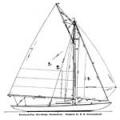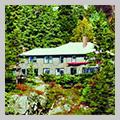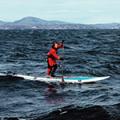The Fine Art of Moose Calling
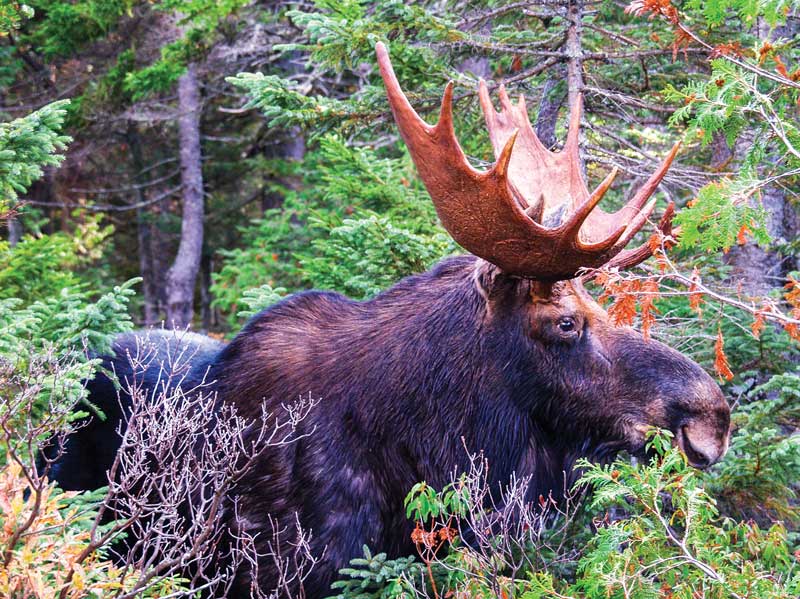 In western and northern Maine, during the annual moose rut from late-September until mid-October, a large bull moose will lose 100 or more pounds battling other bulls to breed as many cow moose as possible. Note the antler battle scar beneath the eye of this bull. Photo by Paul Cyr
In western and northern Maine, during the annual moose rut from late-September until mid-October, a large bull moose will lose 100 or more pounds battling other bulls to breed as many cow moose as possible. Note the antler battle scar beneath the eye of this bull. Photo by Paul Cyr
On a late September day in 1995, shortly after sunset, my friend Gina and I crawled into our sleeping bags at Umsaskis Lake campground. Utterly exhausted from hours of paddling into the Allagash River’s trademark headwinds, we barely enjoyed a dinner of brook trout, pickled fiddleheads, skillet cornbread, and a glass each of merlot. Around midnight, we were awakened by bellowing sounds. Dazed and confused, I wondered if we’d pitched our tent in a Kansas cattle feedlot.
Alarmed, Gina asked, “What are we hearing?”
“It’s the calls of cow moose,” I replied. “They’re eager to breed during rutting season.”
We staggered out of the tent and heard several cows bellowing near and distant. For five minutes, I cupped my hands around my mouth, pinched my nostrils with index fingers, and mimicked a cow moose’s moans. Laughing uncontrollably, we crawled back into our sleeping bags.
The humor, though, was short-lived. An amorous bull moose, tricked by my moose mating calls, came looking for the “cow.” He walked so close to our tent that several guy lines snapped, collapsing the structure. Angered at not finding a sex partner, he demolished a nearby clump of red maple saplings with his massive antlers and toppled our makeshift table, cooking tins, and cookstove. Fearful he’d attack our tent, we dared not move or speak.
At sunrise, our campsite looked like it had been flattened by a mini tornado. My frost-covered wood and canvas canoe, stored upside down, miraculously escaped damage. “Incredible,” Gina exclaimed, eyeing the destruction while clutching a mug of steaming coffee. “It sounded like a monster outside the tent. How big was he?” she asked. My fists barely covered the indentation of half of a hind footprint. “A large adult bull moose, like this one,” I answered, “is at least six feet tall at the shoulders. My guess is he weighs well north of 1,000 pounds.”
Moose dominated our conversations during the 50-mile paddle from Umsaskis to Michaud Farm. When headwinds forced our paddles to dig deep with quicker, synchronized strokes, we lightened the strain by joking about Mona and Lover Boy—our nicknames for the vocal cow and belligerent bull back at the Umsaskis campsite. “Do you think Mona and Lover Boy are a match made in heaven or hell?” Gina asked. We debated the merits of our answers, both agreeing that Lover Boy’s temper should be a red flag for estrous females.
Each subsequent evening we were serenaded by mating calls of cows and grunting bulls, especially at Round Pond, but none matched the sexual fervor at Umsaskis. It was tempting to call another bull, but I refrained.
Our encounter with the Umsaskis bull moose taught me a valuable lesson I’ve applied during the years since when calling moose for hunters, photographers, and friends. Never call a bull moose without a safe exit path to a nearby vehicle, cabin, or four-foot diameter culvert. Renowned moose caller Perley Eastman—my colleague in Aroostook County in 1978, who was crowned champion at a moose calling event in Canada—once sat trapped inside his truck as a bull moose attacked it. “His antlers tore off both side mirrors and scraped the paint from the doors,” Eastman told me. “My wife, who is still angry with me for calling the bull, was sitting in the passenger’s seat.” He added with a laugh, “I had difficulty collecting my auto insurance money. An agent visited my house, took several pictures of the damage, and then sent me a check.”
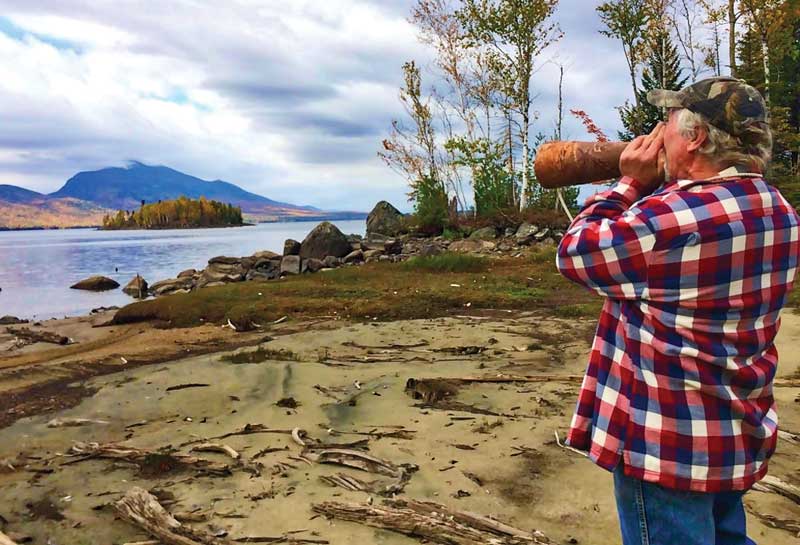 Bull moose in October are so eager to breed they’re easily fooled by imitation cow calls. Since the early 1980s, Registered Maine Guide Greg Drummond has used a birch bark megaphone to call in dozens of bulls for photographers and hunters. Photo courtesy Greg Drummond
Bull moose in October are so eager to breed they’re easily fooled by imitation cow calls. Since the early 1980s, Registered Maine Guide Greg Drummond has used a birch bark megaphone to call in dozens of bulls for photographers and hunters. Photo courtesy Greg Drummond
Greg Drummond, a quintessential Registered Maine Guide, converses with moose year-round. “They don’t answer my calls outside the rut, but I enjoy practicing,” he said with a chuckle. “Come October, especially after a frost, moose often answer my first call. I’ve called dozens of moose within close range, mostly for photographers and nature enthusiasts, but also for hunters.” From 1999 until 2019, Drummond and I teamed up to host Moose Rut Weekend at a sporting lodge he and his wife Pat owned in the western Maine mountains. Co-sponsored by Maine Audubon, the annual event drew a few hundred moose watchers. “Seeing someone awestruck by their first bull moose sighting is very special,” Drummond commented.
One cold October morning in 2002, while Greg and Pat prepared breakfast for a dozen clients, I stepped outside the lodge and imitated a bellowing cow moose. Amid the aroma of frying bacon and faint sounds of laughter in the dining room, a bull moose answered from a wooded hillside. For 10 minutes I waited silently before softly imitating a cow’s long, drawn out moan. The bull immediately answered and came closer. Young bulls often approach cautiously, knowing cows are sometimes paired with an aggressive alpha male, which can lead to battles. I’ve witnessed two such fights. Both bulls, matted coats glistening with perspiration after a 15-minute clash, called it quits, and walked in opposite directions with tongues hanging in exhaustion. Most skirmishes resemble sumo wrestling matches, but a few end in death. In 2006, two large bulls in Aroostook County locked antlers, and, unable to separate, succumbed to exhaustion. The pair are preserved as taxidermy mounts at L.L. Bean’s store in Freeport. The museum-quality display is titled “The Final Charge.”
The Drummonds’ thick forest prevented me from seeing the tentative bull that morning, but he was so close that the top of a sapling swayed as his antlers rocked it. I scampered to the dining room and ordered everyone to follow me. It was a Sunday morning, and we hadn’t seen a moose in two days of calling. Clients quickly grabbed coats, switched slippers for hiking boots, and followed me down the driveway. Greg whispered instructions from the lodge porch, “Get your cameras ready and please don’t talk. The bull is very suspicious.” Clutching cameras and binoculars, we gathered silently at the end of the driveway. Two of us caught a glimpse of the bull’s towering antlers, but nothing else. And then a guest slipped on the frost-covered lodge ramp and fell with a crash. Spooked, the bull wheeled and ran through the forests. We could follow his movements by the loud sounds of breaking limbs and shuddering alders.
An hour later, though, our fortunes improved when Greg’s loud, bellowing cow call attracted a large, handsome bull. Unlike the bull at the lodge, this one was bold. He came to within 50 feet of us and would have come closer had Greg not yelled and waved a wooden canoe paddle. “This bull is determined to mount a cow,” Greg said. “And when they’re hot to trot, there’s almost no stopping them.” The previous evening, Greg had tied a coffee can filled with musky moose pheromones we’d collected from a moose rutting pit (aka moose wallow) where bulls and cows urinate and roll in mud. Based on the bull’s behavior, female pheromones in the can conveyed an urgent “I’m ready to breed” message. Although the estrous cycle averages 24 days, the timeframe she’ll accept a male is relatively short, spanning no more than 36 hours.
It was a tense standoff. The bull’s head was tipped back as he sniffed and licked the air to decode her message. His heightened aggression and lack of fear was driven by a surge in testosterone levels. As his wide antlers rested on his back, cameras fired away while I braced for a charging angry bull. Greg and I had violated our safety rule by venturing too far afield from the vehicles. Greg again yelled at the moose and smacked the paddle several times against a clump of maples. The bull snapped out of his trance, turned, and walked back into the woods. “We were lucky to see that moose, weren’t we?” said a California woman. I nodded in agreement, without mentioning that we were luckier it didn’t charge. “That was a thrill of a lifetime,” she said to a speechless German couple.
Years earlier, Gina had made identical statements when we paddled past a large bull moose standing at the outlet of Round Pond. In 2005, at Gina’s wedding, she introduced me to her husband as “the man I was with the night the Allagash moose scared the bejesus out of me.”
Calling moose is thrilling, but it’s not for the faint of heart.
Writer Ronald Joseph, author of the memoir Bald Eagles, Bear Cubs and Hermit Bill, is a retired wildlife biologist living in central Maine.
Related Articles
Share this article:
2023 Maine Boat & Home Show

Join Us for the Maine Boat & Home Show!
Art, Artisans, Food, Fun & Boats, Boats, Boats
August 11 - 13, 2023 | On the waterfront, Rockland, Maine
Click here to pre-order your tickets.
Show is produced by Maine Boats, Homes & Harbors magazine.







